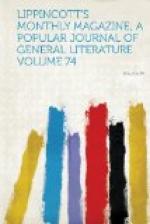This statement relative to the softness of the gem and its subsequent hardening has been met with a shout of derision from some of the gem-seekers—none louder than that of Barbot, the retired jeweler. Barbot seems to forget that the rock of which his own house in Paris is constructed undergoes the same change after being removed from the deep quarries in the catacombs under the city. This phenomenon is observed with many rocks. Flints acquire additional toughness by the evaporation of water contained in them. The steatite of St. Anthony’s Falls grows harder on exposure, and other minerals when quarried from considerable depths become firmer on exposure to the action of the air. Observations of this kind led Kuhlman to investigate the cause, and he believes that the hardening of rocks is not owing solely to the evaporation of quarry-water, but that it depends upon the tendency which all earthy matters possess to undergo a spontaneous crystallization by slow dessication, which commences the moment the rock is exposed to the air.
The coloring matter of the emerald seems to be derived from the decomposition of the remains of animals who have lived in a bygone age, and whose remains are now found fossilized in the rock which forms the matrix of the gem. This rock in Granada is a black limestone, with white veins containing ammonites. Specimens of these rocks exhibiting fragments of emeralds in situ, and also ammonites, are to be seen in the mineralogical gallery of the Jardin des Plantes in Paris. Lewy believes that the beautiful tint of these gems is produced by an organic substance, which he considers to be a carburet of hydrogen, similar to that called chlorophyll, which constitutes the coloring matter of the leaves of plants; and he has shown that the emeralds of the darkest hue, which contain the greatest amount of organic matter, lose their color completely at a low red heat, and become opaque and white; while minerals and pastes which are well known to be colored by chromium, like the green garnets (the lime-chrome garnets) of Siberia, are unchanged in hue by the action of heat.
Since the time of the Spanish Conquest, New Granada has furnished the world with the most of its emeralds. The most famous mines are at Muzo, in the valley of Tunca, between the mountains of New Granada and Popayan, about seventy-five miles from Santa Fe de Bogota, where every rock, it is said, contains an emerald. At present the supply of emeralds is very limited, owing to restrictions on trade and want of capital and energy in mining operations.
Blue as well as green emeralds are found in the Cordillera of the Cubillari. The Esmeraldas mines in Equador are said to have been worked successfully at one period by the Jesuits. The Peruvians obtained many emeralds from the barren district of Atacama, and in the times of the Conquest there were quarries on the River of Emeralds near Barbacoas.




